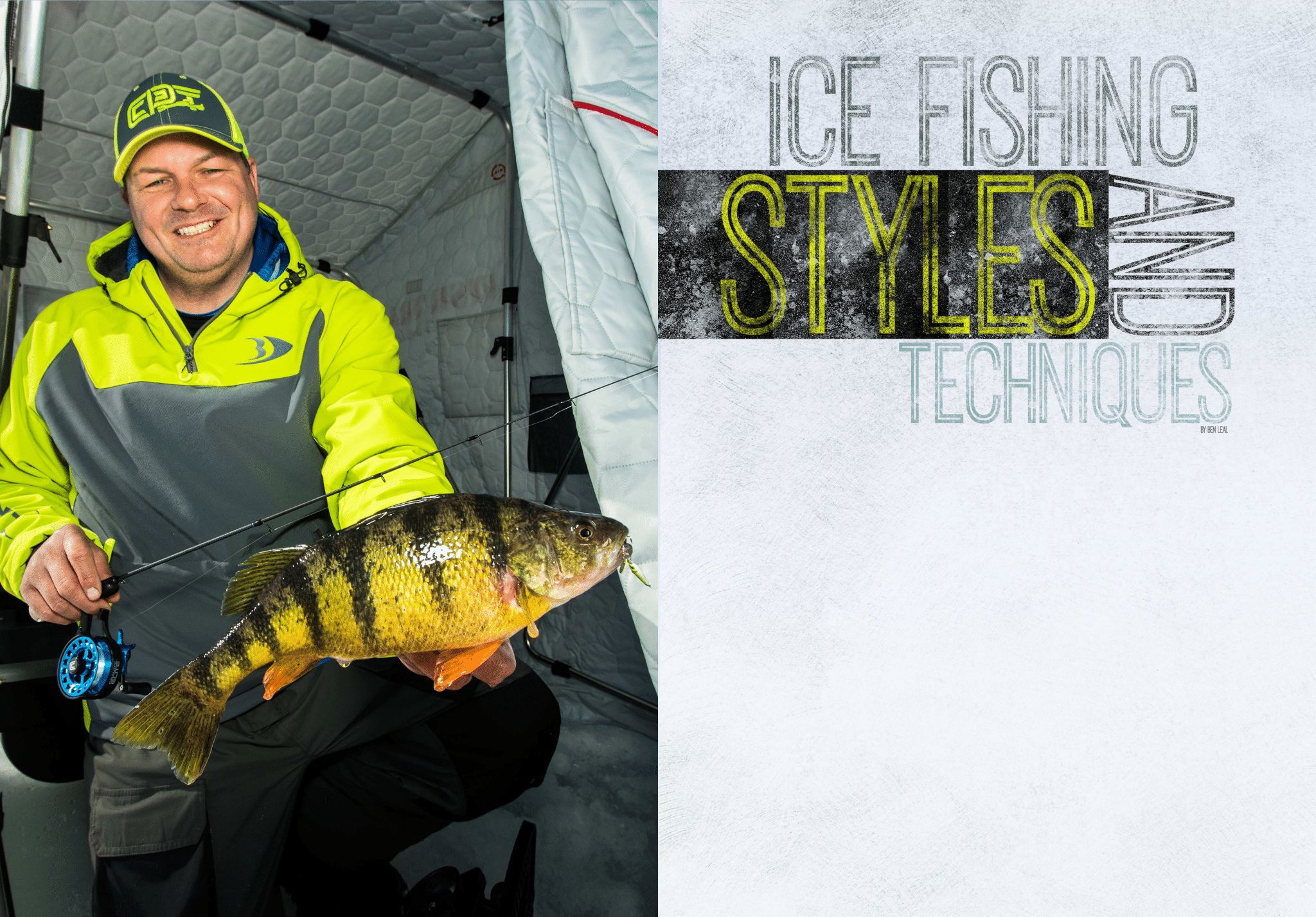Ice Fishing Styles and Techniques

Ice Fishing Styles and Techniques
Ice fishing… you mention that to any number of people from the Southern states, and they will look at you like you have lost your mind. I often post images of myself or my family members out on the ice catching any number and variety of fish. A video of my wife bringing up a very nice catfish brought all kinds of “that looks cold!” comments to “way to go!” and anywhere in between. After almost 20 years of spending time on the ice, I still reflect on my first ice fishing impressions.
Before my first ice fishing adventure, I had visions of an angler out on the ice sitting on a bucket, huddled over a hole trying to keep warm, and sipping on coffee from a red plaid colored thermos. Well honestly, my first few times out on the ice were not too far from what I had envisioned. I was cold, wet, and my style and technique stunk, but over time, things improved; I learned more and more and was more successful than not. I was incredibly proud of the first bluegill I brought up on a new ice fishing rod I had gotten for Christmas all those years ago. And by the way, I was sitting on a bucket, shivering over a hole in the ice.
What is “style”? Well, it certainly could pertain to your clothing or hair, but in this case, the definition we’re looking at is “a manner of doing something.” We all have our fishing styles. If you follow any of the YouTube anglers after a while, you’ll begin to pick up on their fishing styles. Each one will have their kind or “manner of fishing.” My type of fishing is slow and methodical.
Whether I’m fishing in open water during the summer months or on the ice during the winter, I tend to slowly move through an area and try to hit every conceivable spot I think a fish might call home. It’s a bit harder under the ice since you can’t see what’s down there, but if you fish a body of water long enough or often enough throughout the open water season, you’ll remember some of those crappie and bluegill hotspots.
“I’d say my style of ice fishing relies on mobility,” said Coldwater Guide Service owner and Ice Team Pro Rod Woten. “I think being mobile is one of the most important things an ice angler can learn. There isn’t much sense in sticking around any given spot if the fish aren’t there.”
In my years of angling, I’ve seen it repeatedly where I’ll walk by a couple of anglers sitting on the ice and when I come back at the end of my day, those guys are sitting on the same spot!! “Sure, the fish might come in…might being the operative word,” continues Woten. “But instead of taking that chance, I’d much rather go chase them down. Besides, I love getting the first drop down a newly cut hole. Statistically speaking, that first drop is not only your best chance to catch a fish, but it’s also your best shot at catching the biggest fish under that hole.”
Let’s talk a bit about technique, but let’s define the word “technique” before we do. Depending on your use of the word, you can have a variety of definitions, but in this case, we’re going to use “a skillful or efficient way of doing or achieving something.” I used this particular definition of the word because of the word “efficient.” That is something that we’re all trying to be better at through the use technique, right? We want to be more efficient because efficiency means more fish on the ice and, we hope, will produce bigger fish.
For tournament anglers, that’s an essential aspect of ice fishing; if you’re not efficient, you’re not going to be in the running for the ultimate prize. So combining our skill with our efficiency through technique makes us all better anglers.
An ice fishing technique in its simplest form is finding a spot to fish, punching a hole through the ice, and whether you have electronics or not, you start fishing. Pretty basic, however, it’s a starting point and you can build from there.
“Running-and-gunning is a mobility-based technique, but there are even different levels of run-and-gun,” says Woten. “One of the most extreme is when two of us move quickly from hole to hole chasing crappies, checking each hole as we go with our flashers and not even stopping to fish a hole unless we see a suspended mark in that hole. This two-man, tag-team technique can also work very well when searching expansive mudflats for bottom-hugging perch.”
Sight fishing is another technique that Woten brings up, and I’ll say is probably one of my favorite methods to fish. There are a couple of reasons I enjoy this fishing technique. First, you get to see the fish take the jig as you’re working it. Secondly you can learn how your electronics truly react to the fish below the ice. Early in my ice fishing experience, I had the opportunity to fish West Lake Okoboji’s gin-clear water. It truly is a fantastic site to see to the bottom of the lake when you’re in 12 feet of water.
Watching how fish reacted to what I was doing with my rod tip and working the jig was an education in itself. I also placed the Vexilar unit’s transducer in the hole and compared what I saw on the flasher to what was happening beneath the ice. “It allows you to see the fish and their reaction to your presentation. It can be a real eye-opener to see the difference between what you think your presentation looks like and what it actually looks like,” added Woten. Whether you’re a run and gun angler like Woten, or like me, slow and methodical, we can all continue to hone our skills, resulting in better efficiency and more fish on the ice.
Some mistakes anglers make, noted by Woten, are not moving enough and continuing to fish a hole even after it stopped producing. I’m guilty of that at times. You are sitting over a pile of fish where most if not all of them are too small to harvest. “Sure, catching small fish hand over fist can be fun, but is it really what you’re out there for?” pondered Woten. Bringing too much gear out on the ice, (guilty), sometimes less is more. “Work to refine your system each trip out.”
Tips on styles and techniques could be an entire article unto itself. But we will leave you with a few gems here. “Be passionate about learning different techniques. Ice fishing techniques tend to be regional; sight fishing, long-rodding, palm rods are just a few examples,” says Woten. “I was blessed during my tournament fishing years to be able to fish with many outstanding ice anglers from all over the ice belt, and I was able to learn lots of different techniques from them.” Don’t be afraid to learn new things. Attend as many seminars as you can, and most of the time they’re free.
“When I was just getting started in the ice fishing industry, I sat through every seminar I could from the likes of Dave Genz, Jason Mitchell, Tony Boshold, Brian Brosdahl, Greg Wilcynzky, the list goes on,” he continued. “Most good bait and tackle shops will have season kickoff events nowadays with great seminars as do several major retailers. And of course, the big ice fishing sports shows always have a star-packed line up of seminar speakers.”
Styles and techniques of angling are unique and individual like us all. Hone your skill and become that efficient angler you’ve always wanted to be. Do not forget to introduce new anglers to the sport of ice fishing…young and old alike, our sport’s future lies in those that are new to it. Limit your catch, don’t catch your limit, and always remember to pack out what you packed in. Tight lines all!
by Ben Leal
January 2021

